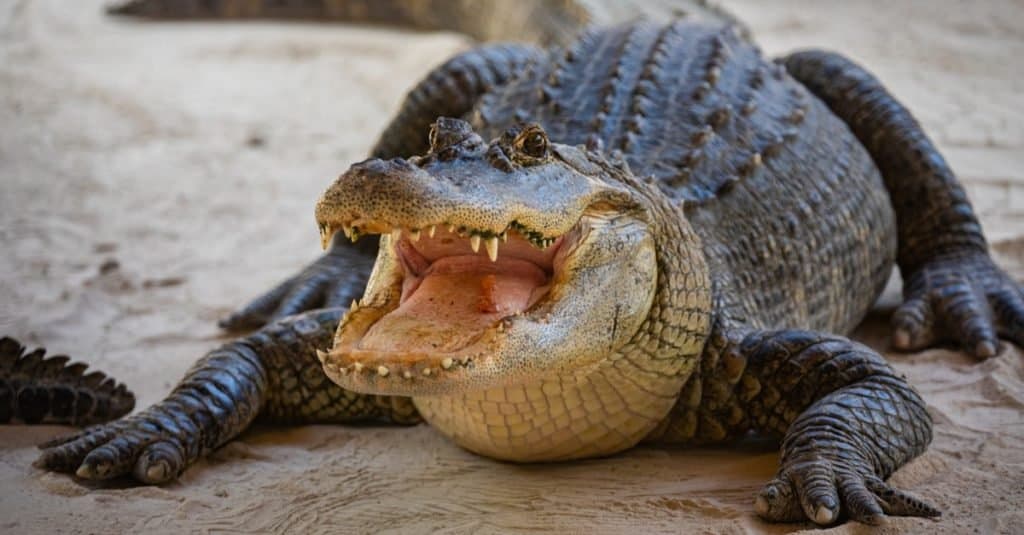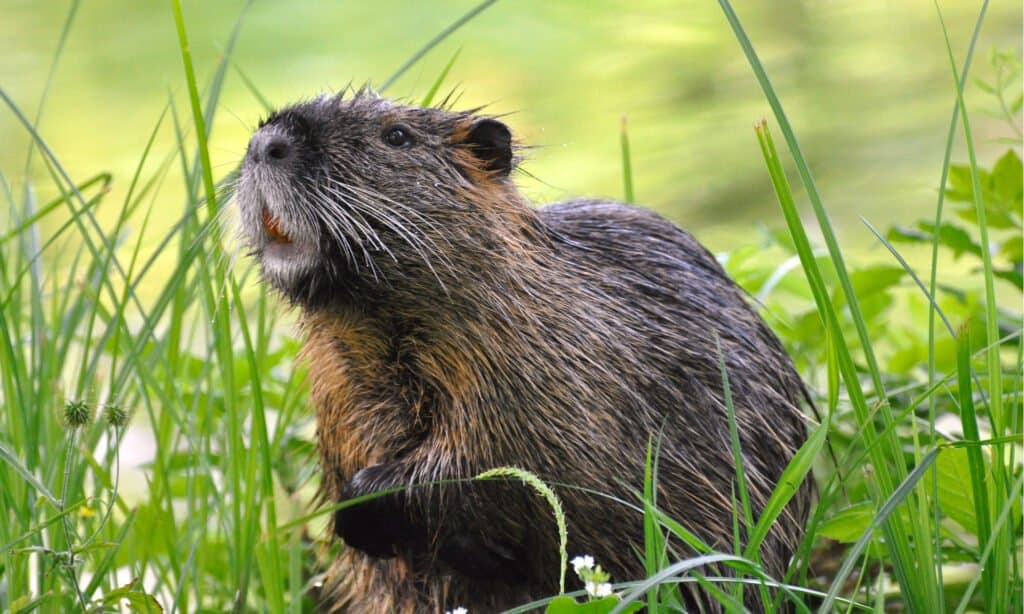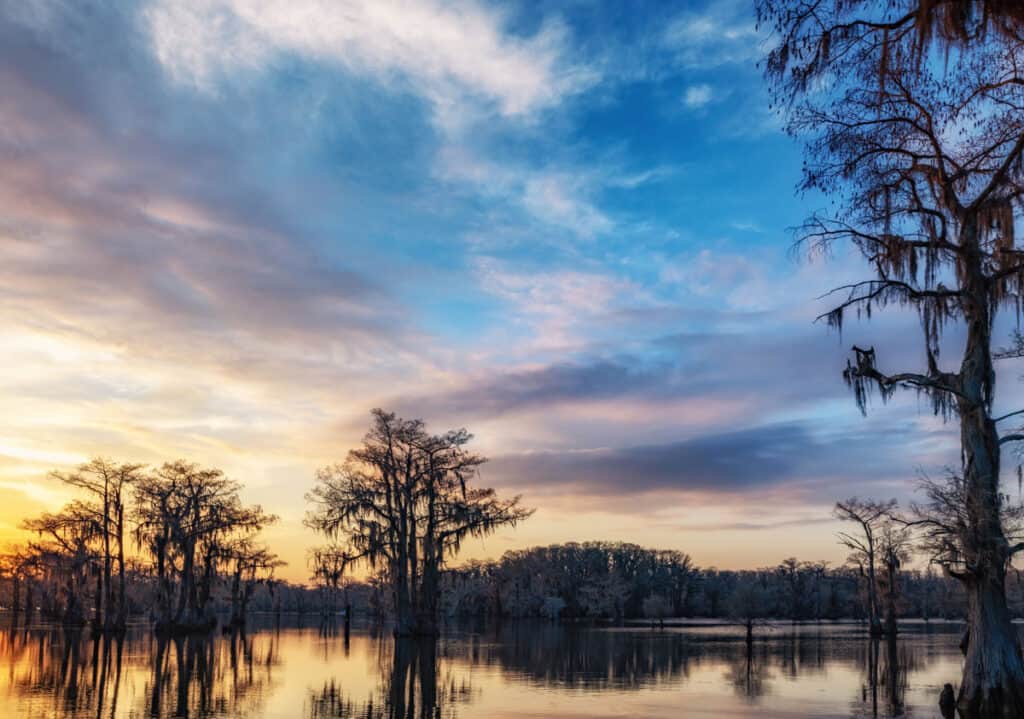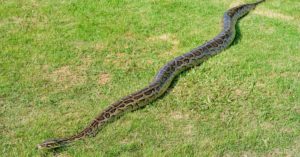Key Points:
- There are more than 2 million alligators in the wild in Louisiana, which has the world’s biggest alligator population.
- Some of the state’s most alligator-infested lakes include Lake Martin, Caddo Lake, and Cross Lake.
- In addition to lakes, alligators can be found in coastal marshes, the Cypress-tupelo swamp, and the Atchafalaya Basin swamp.
Louisiana has the largest alligator population in the world. There are more than 2 million alligators in the wild and another 1 million that live on alligator farms. Florida has the second-largest population of alligators with 1.3 million gators.
If you want to know where to find them to catch a photo from a distance or so that you can avoid them at all costs, let’s look at where most alligators live. Read on to discover the most alligator-infested lakes in Louisiana.
Where Do Alligators Live in Louisiana?

Louisiana has the most alligators in the world. There are more than 2 million alligators in the state.
©Robert Gregory Griffeth/Shutterstock.com
Alligators live in and around water including swamps, marshes, bayous, canals, rivers, and lakes. In Louisiana, most of the alligators live along the coast in the marsh areas. They are mostly freshwater animals but can tolerate salt water so the brackish water along the coast in a fine environment for them. They inhabit:
- Coastal marshes (3 million acres)
- Cypress-tupelo swamp (750,600 acres)
- Atchafalaya Basin swamp (207,000 acres)
- Lakes (32,105 acres).
While most alligators can be found along the coast, this article will look specifically at the most alligator-infested lakes in Louisiana.
4 Alligator-Infested Lakes in Louisiana
1. Lake Martin

Alligators can be seen basking in the sun around Lake Martin.
©Mia2you/Shutterstock.com
Lake Martin is definitely one of the most alligator-infested lakes in Louisiana. It is located in the Cypress Island Nature Preserve, just west of the Atchafalaya National Wildlife Refuge. There is a bridge along the lake where you can usually spot alligators from. If you are a little braver you can venture out in a canoe or kayak.
The alligators can be seen swimming sometimes with just their eyes and nostrils above the water or basking in the sun on the shore. You may see an alligator on the shore with its mouth open. They are not waiting to attack but their mouth serves as an air conditioner of sorts. Alligators open their mouths to help them regulate their temperature. Cold-blooded reptiles have to be able to adjust to their environment. They may just be showing off their teeth!
There are many fish, frogs, turtles, and birds in and around Lake Martin, all part of the diet of the Alligator. The lake is also home to nutrias (coypus), which are large semi-aquatic rodents that can get to be 2 feet long and weigh 35 pounds! If a nutria comes down to the water’s edge to get a drink they are risking becoming dinner for the alligator. Alligators often hide in the water and wait for prey then spring and attack, swallowing the animal whole.

Looks like it could be nutria for dinner tonight! These large rodents live by Lake Martin and are one of the animals alligators eat.
©Sonja Guijarro/Shutterstock.com
2. Caddo Lake

Caddo Lake 26,810-acre lake is home to some of the most alligators in any lake in the state.
©iStock.com/westtexasfish
Caddo Lake is located in the far northwest corner of the state. It is in Caddo Parish, Louisiana, and Harrison and Marion Counties in Texas. About half the lake is in Louisiana and the other half is in Texas. This large 26,810-acre lake is home to some of the most alligators in any lake in the state. Alligators are around 12 feet long and can weigh 1,000 pounds. If you want to see one (on purpose) you can rent a canoe or kayak and explore along the edge of the lake. If you want to avoid alligators, then this lake and park are not for you!
On May 22, 2016, Jeremy Moore caught an enormous alligator in Caddo Lake. He was on the Texas side when he and his dad and two young sons found the giant gator lying on the bank of the lake. They thought maybe it was already dead because it remained so still. When it finally moved its head they shot it. The alligator was 13 feet 2 inches and weighed 900 pounds! They were not in the park, they were hunting on private land so it was legal for him to take it with him (although it took a while and a lot of help to get it into the back of his pick up!). With alligators that big, it is safe to say that Caddo Lake is not a great place for an afternoon swim.
Cross Lake
Cross Lake is located not far from Caddo Lake. It is near the town of Shreveport in northwestern Louisiana. The 8,960-acre lake is a good place to go hunting for alligators. You do need to follow the hunting regulations and obtain the proper tag.
It is a recreational lake and there are many areas where you can go swimming. The alligators tend to live in the bayous and canals in and around the lake. As with all lakes, ponds, and waterways in the state, you should not swim at night, this is when alligators are most likely to be hunting and you don’t want to tempt one.
Cypress Lake

Cypress Lake is on the campus of the University of Louisiana, Lafayette. They have live alligators living in the lake … on campus!
©Jcarriere (talk) (Uploads) / Public Domain – License
It may surprise you to learn that the University of Louisiana campus in Lafayette has a lake on campus that is home to a population of alligators! Cypress Lake is a small, 2-acre lake that has become a popular tourist attraction due to the alligators.
There is a deck near the dining hall where visitors can look for alligators and often see them getting some sun. Other wildlife you might see include yellow-bellied and red-bellied turtles, snapping turtles, garfish, bass, and carp.
You would think alligators on campus would be a risky thing, but there have never been any accidents from the alligators. They do occasionally wander out of the lake and have been found near the dorms or in the parking lot. When these are reported the university police call the Louisiana Department of Wildlife and Fisheries, and they come and relocate the alligator into the wild.
There are definitely some places in Louisiana where you can find the most alligator-infested lakes. Remember to always keep a safe distance when observing wildlife and be prepared if you ever choose to tour the campus of the University of Louisiana.
Do Alligators Live in Groups?
Alligators, especially adult males, live mostly on their own. So if you are thinking of finding a lake full of hundreds of thrashing alligators you will be disappointed. Crocodiles are more social and the ones you might commonly see basking in the sun together. Alligators will do the same, gathering to bask in the sun, but for the most part, they will be seen individually. During the mating season, there will be socializing and fighting among the alligators. When they do gather together a group of alligators is called a congregation!
Is It Normal for Alligators to Infest Lakes?
It is not considered normal behavior for alligators to infest the lakes they live in. Alligators are apex predators in their environments and typically occupy a specific territory and hunt for food within that area. While alligator populations can become dense in certain habitats, they do not infest an entire lake or body of water.
It is also important to note that alligator populations are regulated by hunting and habitat management programs to ensure their populations remain healthy and balanced with their habitats.
Alligators are native to the United States and can be found in the southeastern states, primarily Florida and Louisiana. They occupy a variety of habitats, including freshwater marshes, swamps, rivers, and lakes. Alligators are opportunistic feeders and will consume a variety of prey, including fish, reptiles, birds, and small mammals.
In areas with high alligator populations, it is not uncommon for alligators to come into conflict with humans, especially in residential or recreational areas near water. To mitigate these conflicts, alligator management programs have been implemented, which include population control through hunting and habitat management.
It is important to understand that alligators play a crucial role in their ecosystem as apex predators, controlling the populations of other species and maintaining a balance in the food chain. They are also an important part of the cultural and ecological heritage of the southeastern United States and are protected by law.
It is recommended that people take precautions when recreating near alligator habitats, such as avoiding swimming in areas where alligators are known to be present and keeping a safe distance from alligators on the shore or in the water.
Summary of the Most Alligator-Infested Lakes in Louisiana
Here’s a recap of the lakes in the state of Louisiana that have large alligator populations:
| Number | Lake | Location |
|---|---|---|
| 1 | Lake Martin | Cypress Island Nature Preserve |
| 2 | Caddo Lake | Caddo Parish in Louisiana and Harrison and Marion Counties in Texas |
| 3 | Cross Lake | Shreveport |
| 4 | Cypress Lake | University of Louisiana campus, Lafayette |
The photo featured at the top of this post is © tswinner/Shutterstock.com
Thank you for reading! Have some feedback for us? Contact the AZ Animals editorial team.







